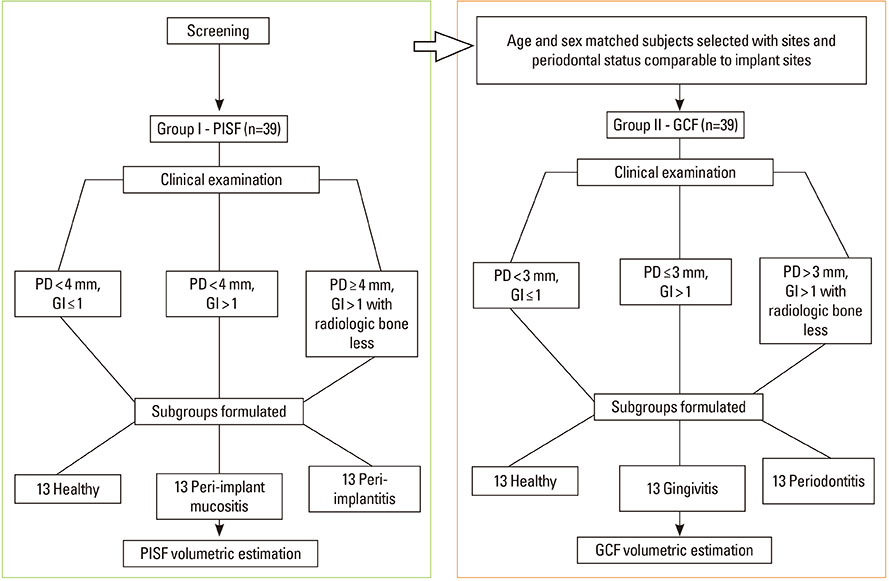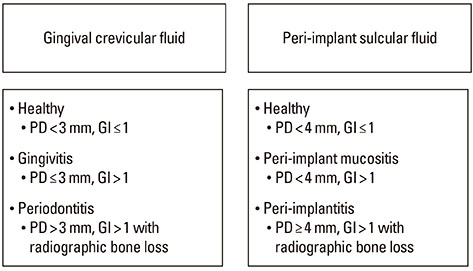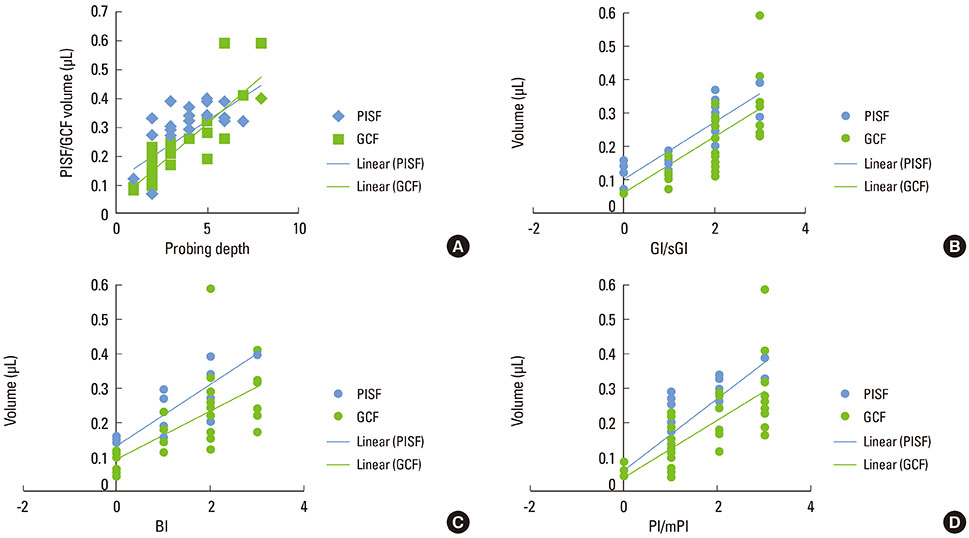J Periodontal Implant Sci.
2013 Oct;43(5):233-242. 10.5051/jpis.2013.43.5.233.
Comparative volumetric and clinical evaluation of peri-implant sulcular fluid and gingival crevicular fluid
- Affiliations
-
- 1Department of Periodontology, Krishnadevaraya College of Dental Sciences and Hospital, Bangalore, India. smitibhardwaj@gmail.com
- KMID: 2212033
- DOI: http://doi.org/10.5051/jpis.2013.43.5.233
Abstract
- PURPOSE
Peri-implant sulcular fluid (PISF) has a production mechanism similar to gingival crevicular fluid (GCF). However, limited research has been performed comparing their behavior in response to inflammation. Hence, the aim of the present study was to comparatively evaluate PISF and GCF volume with varying degrees of clinical inflammatory parameters.
METHODS
Screening of patients was conducted. Based on the perimucosal inflammatory status, 39 loaded implant sites were selected from 24 patients, with equal numbers of sites in healthy, peri-implant mucositis, and peri-implantitis subgroups. GCF collection was done from age- and sex-matched dentate patients, selected with gingival inflammatory status corresponding to the implant sites. Assessment of the inflammatory status for dental/implant sites was performed using probing depth (PD), plaque index/modified plaque index (PI/mPI), gingival index/simplified gingival index (GI/sGI), and modified sulcular bleeding index (BI). Sample collection was done using standardized absorbent paper strips with volumetric evaluation performed via an electronic volume quantification device.
RESULTS
Positive correlation of the PISF and GCF volume was seen with increasing PD and clinical inflammatory parameters. A higher correlation of GCF with PD (0.843) was found when compared to PISF (0.771). PISF expressed a higher covariation with increasing grades of sGI (0.885), BI (0.841), and mPI (0.734), while GCF established a moderately positive correlation with GI (0.694), BI (0.696), and PI (0.729).
CONCLUSIONS
Within the limitations of this study, except for minor fluctuations, GCF and PISF volumes demonstrated a similar nature and volumetric pattern through increasing grades of inflammation, with PISF showing better correlation with the clinical parameters.
MeSH Terms
Figure
Cited by 1 articles
-
Peri-implant crevicular fluid levels of cathepsin-K, RANKL, and OPG around standard, short, and mini dental implants after prosthodontic loading
Raif Alan, İsmail Marakoğlu, Seyfullah Haliloğlu
J Periodontal Implant Sci. 2015;45(5):169-177. doi: 10.5051/jpis.2015.45.5.169.
Reference
-
1. American Academy of Periodontology. Glossary of periodontal terms. Chicago: American Academy of Periodontology;2001.2. Loe H, Silness J. Periodontal disease in pregnancy. I. Prevalence and severity. Acta Odontol Scand. 1963; 21:533–551.
Article3. Loe H. The gingival index, the plaque index and the retention index systems. J Periodontol. 1967; 38(6):Suppl. 610–616.
Article4. Mombelli A, van Oosten MA, Schurch E Jr, Land NP. The microbiota associated with successful or failing osseointegrated titanium implants. Oral Microbiol Immunol. 1987; 2:145–151.
Article5. Lindquist LW, Rockler B, Carlsson GE. Bone resorption around fixtures in edentulous patients treated with mandibular fixed tissue-integrated prostheses. J Prosthet Dent. 1988; 59:59–63.
Article6. Apse P, Zarb GA, Schmitt A, Lewis DW. The longitudinal effectiveness of osseointegrated dental implants. The Toronto Study: peri-implant mucosal response. Int J Periodontics Restorative Dent. 1991; 11:94–111.7. Gargiulo AW, Wentz FM, Orban B. Dimensions and relations of dentogingival junctions in humans. J Periodontol. 1961; 32:261–267.8. Karbach J, Callaway A, Kwon YD, d'Hoedt B, Al-Nawas B. Comparison of five parameters as risk factors for peri-mucositis. Int J Oral Maxillofac Implants. 2009; 24:491–496.9. Black GV. The fibers and glands of the peridental membrane. Dent Cosmos. 1899; 41:101–122.10. Brill N. Influence of capillary permeability on flow of tissue fluid into gingival pockets. Acta Odontol Scand. 1959; 17:23–33.
Article11. Egelberg J. Permeability of the dento-gingival blood vessels. 1. Application of the vascular labelling method and gingival fluid measurements. J Periodontal Res. 1966; 1:180–191.12. Egelberg J. Permeability of the dento-gingival blood vessels. III. Chronically inflamed gingivae. J Periodontal Res. 1966; 1:287–296.13. Alfano MC. The origin of gingival fluid. J Theor Biol. 1974; 47:127–136.
Article14. Pashley DH. A mechanistic analysis of gingival fluid production. J Periodontal Res. 1976; 11:121–134.
Article15. Griffiths GS, Sterne JA, Wilton JM, Eaton KA, Johnson NW. Associations between volume and flow rate of gingival crevicular fluid and clinical assessments of gingival inflammation in a population of British male adolescents. J Clin Periodontol. 1992; 19:464–470.
Article16. Ozkavaf A, Aras H, Huri CB, Mottaghian-Dini F, Tozum TF, Etikan I, et al. Relationship between the quantity of gingival crevicular fluid and clinical periodontal status. J Oral Sci. 2000; 42:231–238.
Article17. Lindhe J, Hamp SE, Loe H. Experimental periodontitis in the beagle dog. Int Dent J. 1973; 23:432–437.
Article18. Stewart JE, Christenson PD, Maeder LA, Palmer MA. Reliability of filter-strip sampling of gingival crevicular fluid for volume determination using the Periotron. J Periodontal Res. 1993; 28:227–230.
Article19. Apse P, Ellen RP, Overall CM, Zarb GA. Microbiota and crevicular fluid collagenase activity in the osseointegrated dental implant sulcus: a comparison of sites in edentulous and partially edentulous patients. J Periodontal Res. 1989; 24:96–105.
Article20. Lang NP, Berglundh T. Working Group 4 of Seventh European Workshop on Periodontology. Periimplant diseases: where are we now? Consensus of the Seventh European Workshop on Periodontology. J Clin Periodontol. 2011; 38:Suppl 11. 178–181.
Article21. Hatipoglu H, Yamalik N, Berberoglu A, Eratalay K. Impact of the distinct sampling area on volumetric features of gingival crevicular fluid. J Periodontol. 2007; 78:705–715.
Article22. Tozum TF, Hatipoglu H, Yamalik N, Gursel M, Alptekin NO, Ataoglu T, et al. Critical steps in electronic volume quantification of gingival crevicular fluid: the potential impact of evaporation, fluid retention, local conditions and repeated measurements. J Periodontal Res. 2004; 39:344–357.
Article23. Ciantar M, Caruana DJ. Periotron 8000: calibration characteristics and reliability. J Periodontal Res. 1998; 33:259–264.
Article24. Lindhe J, Meyle J. Group D of European Workshop on Periodontology. Peri-implant diseases: Consensus Report of the Sixth European Workshop on Periodontology. J Clin Periodontol. 2008; 35:8 Suppl. 282–285.
Article25. Lang NP, Bosshardt DD, Lulic M. Do mucositis lesions around implants differ from gingivitis lesions around teeth? J Clin Periodontol. 2011; 38:Suppl 11. 182–187.
Article26. Froum SJ, Rosen PS. A proposed classification for peri-implantitis. Int J Periodontics Restorative Dent. 2012; 32:533–540.27. Mombelli A, Graf H. Depth-force-patterns in periodontal probing. J Clin Periodontol. 1986; 13:126–130.
Article28. Strbac GD, Monov G, Cei S, Kandler B, Watzek G, Gruber R. Cathepsin K levels in the crevicular fluid of dental implants: a pilot study. J Clin Periodontol. 2006; 33:302–308.
Article29. Salvi GE, Lang NP. Diagnostic parameters for monitoring peri-implant conditions. Int J Oral Maxillofac Implants. 2004; 19:Suppl. 116–127.30. Luterbacher S, Mayfield L, Bragger U, Lang NP. Diagnostic characteristics of clinical and microbiological tests for monitoring periodontal and peri-implant mucosal tissue conditions during supportive periodontal therapy (SPT). Clin Oral Implants Res. 2000; 11:521–529.
Article31. Listgarten MA, Lang NP, Schroeder HE, Schroeder A. Periodontal tissues and their counterparts around endosseous implants. Clin Oral Implants Res. 1991; 2:1–19.
Article32. Chaytor DV, Zarb GA, Schmitt A, Lewis DW. The longitudinal effectiveness of osseointegrated dental implants. The Toronto Study: bone level changes. Int J Periodontics Restorative Dent. 1991; 11:112–125.33. Schierano G, Pejrone G, Brusco P, Trombetta A, Martinasso G, Preti G, et al. TNF-alpha TGF-beta2 and IL-1beta levels in gingival and peri-implant crevicular fluid before and after de novo plaque accumulation. J Clin Periodontol. 2008; 35:532–538.
Article34. Gunday S, Topcu AO, Guncu GN, Akman CS, Karabulut E, Yamalik N. Analysis of potential factors affecting peri implant sulcus fluid volume. Clinical Dent Res. 2011; 35:12–24.35. Tozum TF, Turkyilmaz I, Yamalik N, Tumer C, Kilinc A, Kilinc K, et al. Analysis of thte possible impact of inflammation severity and early and delayed loading on nitric oxide metabolism around dental implants. Int J Oral Maxillofac Implants. 2005; 20:547–556.36. Guncu GN, Tozum TF, Guncu MB, Yamalik N, Tümer C, Karabulut E, et al. Myeloperoxidase as a measure of polymorphonuclear leukocyte response in inflammatory status around immediately and delayed loaded dental implants: a randomized controlled clinical trial. Clin Implant Dent Relat Res. 2008; 10:30–39.
Article37. Tozum TF, Guncu GN, Yamalik N, Turkyilmaz I, Guncu MB. The impact of prosthetic design on the stability, marginal bone loss, peri-implant sulcus fluid volume, and nitric oxide metabolism of conventionally loaded endosseous dental implants: a 12-month clinical study. J Periodontol. 2008; 79:55–63.
Article38. Mann WV. The correlation of gingivitis pocket depth and exudate from the gingival crevice. J Periodontol. 1963; 34:379–387.
Article39. Oliver RC, Holm-Pederen P, Loe H. The correlation between clinical scoring, exudate measurements and microscopic evaluation of inflammation in the gingiva. J Periodontol. 1969; 40:201–209.
Article40. Niimi A, Ueda M. Crevicular fluid in the osseointegrated implant sulcus: a pilot study. Int J Oral Maxillofac Implants. 1995; 10:434–436.
- Full Text Links
- Actions
-
Cited
- CITED
-
- Close
- Share
- Similar articles
-
- Assessment of interleukin-1beta and interleukin-6 in the crevicular fluid around healthy implants, implants with peri-implantitis, and healthy teeth: a cross-sectional study
- Study on the correlation of periodontopathic microflora and gingival crevicular fluid cytokine on periodontal disease progression
- Dynamics of gingival crevicular fluid volume and enzyme activities after application of orthodontic force
- A clinical study of the effects of orthodontic appliances on the gingival tissue
- Identification of tumor necrosis factor-alpha levels around miniscrews during canine distalization




